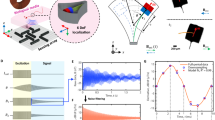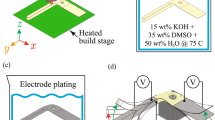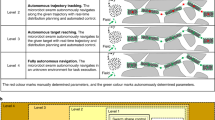Abstract
Magnetic microrobots have shown promise in the field of biomedical engineering, facilitating precise drug delivery, non-invasive diagnosis and cell-based therapy. Current techniques for controlling the motion of such microrobots rely on the assumption of homogenous magnetic fields and are significantly influenced by a microrobot’s properties and surrounding environment. These strategies lack a sense of generality and adaptability when changing the environment or microrobot and exhibit a moderate delay due to independent control of the electromagnetic actuation system and microrobot’s position. To address these issues, we propose a machine learning-based positional control of magnetic microrobots via gradient fields generated by electromagnetic coils. We use reinforcement learning and a gradual training approach to control the three-dimensional position of a microrobot within a defined working area by directly managing the coil currents. We develop a simulation environment for initial exploration to reduce the overall training time. After simulation training, the learning process is transferred to a physical electromagnetic actuation system that reflects real-world intricacies. We compare our method to conventional proportional-integral-derivative control; our system is more accurate and efficient. The proposed method was combined with path planning algorithms to allow fully autonomous control. The presented approach is an alternative to complex mathematical models, which are sensitive to variations in microrobot design, the environment and the nonlinearity of magnetic systems.
This is a preview of subscription content, access via your institution
Access options
Access Nature and 54 other Nature Portfolio journals
Get Nature+, our best-value online-access subscription
$29.99 / 30 days
cancel any time
Subscribe to this journal
Receive 12 digital issues and online access to articles
$119.00 per year
only $9.92 per issue
Buy this article
- Purchase on Springer Link
- Instant access to full article PDF
Prices may be subject to local taxes which are calculated during checkout






Similar content being viewed by others
Data availability
No public or custom dataset was used for this study. All the data required to replicate the results of this study are given in the main article, Supplementary Information and the GitHub repository.
Code availability
All the data were processed using custom codes. Custom codes along with source code for the simulation environment are available at the GitHub repository: https://github.com/sarmadnabbasi/Autonomous-3D-positional-control-of-a-magnetic-microrobot-using-reinforcement-learning (ref. 71).
References
Wang, B., Kostarelos, K., Nelson, B. J. & Zhang, L. Trends in micro‐/nanorobotics: materials development, actuation, localization, and system integration for biomedical applications. Adv. Mater. 33, 2002047 (2021).
Wang, B. et al. Endoscopy-assisted magnetic navigation of biohybrid soft microrobots with rapid endoluminal delivery and imaging. Sci. Robot 6, eabd2813 (2021).
Erkoc, P. et al. Mobile microrobots for active therapeutic delivery. Adv. Ther. 2, 1800064 (2019).
Nauber, R. et al. Medical microrobots in reproductive medicine from the bench to the clinic. Nat. Commun. 14, 728 (2023).
Wang, Y. et al. Microrobots for targeted delivery and therapy in digestive system. ACS Nano 17, 27–50 (2023).
Vikram Singh, A. & Sitti, M. Targeted drug delivery and imaging using mobile milli/microrobots: a promising future towards theranostic pharmaceutical design. Curr. Pharm. Des. 22, 1418–1428 (2016).
Gao, W. et al. Artificial micromotors in the mouse’s stomach: a step toward in vivo use of synthetic motors. ACS Nano 9, 117–123 (2015).
Li, J. et al. Development of a magnetic microrobot for carrying and delivering targeted cells. Sci. Robot 3, eaat8829 (2018).
Zhang, H. et al. Dual-responsive biohybrid neutrobots for active target delivery. Sci. Robot 6, eaaz9519 (2021).
Sitti, M. et al. Biomedical applications of untethered mobile milli/microrobots. Proc. IEEE 103, 205–224 (2015).
Li, J., Mayorga‐Martinez, C. C., Ohl, C. & Pumera, M. Ultrasonically propelled micro‐ and nanorobots. Adv. Funct. Mater. 32, 2102265 (2022).
Wang, J., Dong, R., Wu, H., Cai, Y. & Ren, B. A review on artificial micro/nanomotors for cancer-targeted delivery. Diagn.Ther. Nanomicro. Lett. 12, 11 (2020).
Hou, Y. et al. A review on microrobots driven by optical and magnetic fields. Lab. Chip https://doi.org/10.1039/D2LC00573E (2023).
Sitti, M. & Wiersma, D. S. Pros and cons: magnetic versus optical microrobots. Adv. Mater. 32, 1906766 (2020).
Zhou, H., Mayorga-Martinez, C. C., Pané, S., Zhang, L. & Pumera, M. Magnetically driven micro and nanorobots. Chem. Rev. 121, 4999–5041 (2021).
Choi, J., Hwang, J., Kim, J. & Choi, H. Recent progress in magnetically actuated microrobots for targeted delivery of therapeutic agents. Adv. Healthc. Mater 10, 2001596 (2021).
Ebrahimi, N. et al. Magnetic actuation methods in bio/soft robotics. Adv. Funct. Mater. 31, 2005137 (2021).
Yan, X. et al. Multifunctional biohybrid magnetite microrobots for imaging-guided therapy. Sci. Robot 2, eaaq1155 (2017).
Kim, S. et al. Fabrication and characterization of magnetic microrobots for three‐dimensional cell culture and targeted transportation. Adv. Mater. 25, 5863–5868 (2013).
Zhang, L. et al. Artificial bacterial flagella: fabrication and magnetic control. Appl. Phys. Lett. 94, 064107 (2009).
Wang, X. et al. 3D printed enzymatically biodegradable soft helical microswimmers. Adv. Funct. Mater. 28, 1804107 (2018).
Xin, C. et al. Conical hollow microhelices with superior swimming capabilities for targeted cargo delivery. Adv. Mater. 31, 1808226 (2019).
Ceylan, H. et al. 3D-printed biodegradable microswimmer for theranostic cargo delivery and release. ACS Nano 13, 3353–3362 (2019).
Jeon, S. et al. Magnetically actuated microrobots as a platform for stem cell transplantation. Sci. Robot 4, eaav4317 (2019).
Alapan, Y., Bozuyuk, U., Erkoc, P., Karacakol, A. C. & Sitti, M. Multifunctional surface microrollers for targeted cargo delivery in physiological blood flow. Sci. Robot 5, eaba5726c (2020).
Khalil, I. S. M. et al. Swimming back and forth using planar flagellar propulsion at low Reynolds numbers. Adv. Sci. 5, 1700461 (2018).
Khalil, I. S. M. et al. Independent actuation of two-tailed microrobots. IEEE Robot. Autom. Lett. 3, 1703–1710 (2018).
Yang, Z. & Zhang, L. Magnetic actuation systems for miniature robots: a review. Adv. Intell. Syst. 2, 2000082 (2020).
Chen, R., Folio, D. & Ferreira, A. Analysis and comparison of electromagnetic microrobotic platforms for biomedical applications. Appl. Sci. 12, 456 (2022).
Hwang, J., Kim, J. & Choi, H. A review of magnetic actuation systems and magnetically actuated guidewire- and catheter-based microrobots for vascular interventions. Intell. Serv. Robot. 13, 1–14 (2020).
Kummer, M. P. et al. OctoMag: an electromagnetic system for 5-DOF wireless micromanipulation. In Proc. 2010 IEEE International Conference on Robotics and Automation 1610–1616 (IEEE, 2010).
Yang, L., Du, X., Yu, E., Jin, D. & Zhang, L. DeltaMag: an electromagnetic manipulation system with parallel mobile coils. In Proc. 2019 International Conference on Robotics and Automation (ICRA) 9814–9820 (IEEE, 2019).
Ongaro, F., Pane, S., Scheggi, S. & Misra, S. Design of an electromagnetic setup for independent three-dimensional control of pairs of identical and nonidentical microrobots. IEEE Trans. Rob. 35, 174–183 (2019).
Yang, L. & Zhang, L. Motion control in magnetic microrobotics: from individual and multiple robots to swarms. Annu. Rev. Control Robot. Auton. Syst. 4, 509–534 (2021).
LeCun, Y., Bengio, Y. & Hinton, G. Deep learning. Nature 521, 436–444 (2015).
Saxe, A., Nelli, S. & Summerfield, C. If deep learning is the answer, what is the question? Nat. Rev. Neurosci. 22, 55–67 (2021).
Yuan, X., Shi, J. & Gu, L. A review of deep learning methods for semantic segmentation of remote sensing imagery. Expert Syst. Appl. 169, 114417 (2021).
Shamshirband, S., Fathi, M., Dehzangi, A., Chronopoulos, A. T. & Alinejad-Rokny, H. A review on deep learning approaches in healthcare systems: taxonomies, challenges, and open issues. J. Biomed. Inform. 113, 103627 (2021).
Kiran, B. R. et al. Deep reinforcement learning for autonomous driving: a survey. IEEE Trans. Intell. Transp. Syst. 23, 4909–4926 (2022).
Justesen, N., Bontrager, P., Togelius, J. & Risi, S. Deep learning for video game playing. IEEE Trans Games 12, 1–20 (2020).
Liu, R., Nageotte, F., Zanne, P., de Mathelin, M. & Dresp-Langley, B. Deep reinforcement learning for the control of robotic manipulation: a focussed mini-review. Robotics 10, 22 (2021).
Soria, E., Schiano, F. & Floreano, D. Predictive control of aerial swarms in cluttered environments. Nat. Mach. Intell. 3, 545–554 (2021).
Cichos, F., Gustavsson, K., Mehlig, B. & Volpe, G. Machine learning for active matter. Nat. Mach. Intell. 2, 94–103 (2020).
Sutton, R. S. & Barto, A. G. Reinforcement learning: an introduction. IEEE Trans. Neural Netw. 9, 1054–1054 (1998).
Tsang, A. C. H., Demir, E., Ding, Y. & Pak, O. S. Roads to smart artificial microswimmers. Adv. Intell. Syst. 2, 1900137 (2020).
Yu, S., Cai, Y., Wu, Z. & He, Q. Recent progress on motion control of swimming micro/nanorobots. VIEW 2, 20200113 (2021).
Jiang, J., Yang, Z., Ferreira, A. & Zhang, L. Control and autonomy of microrobots: recent progress and perspective. Adv. Intell. Syst. 4, 2100279 (2022).
Yang, Y., Bevan, M. A. & Li, B. Efficient navigation of colloidal robots in an unknown environment via deep reinforcement learning. Adv. Intell. Syst. 2, 1900106 (2020).
Muiños-Landin, S., Fischer, A., Holubec, V. & Cichos, F. Reinforcement learning with artificial microswimmers.Sci. Robot. 6, eabd9285 (2021).
Liu, Y., Zou, Z., Tsang, A. C. H., Pak, O. S. & Young, Y.-N. Mechanical rotation at low Reynolds number via reinforcement learning. Phys. Fluids 33, 062007 (2021).
Yang, Y., Bevan, M. A. & Li, B. Hierarchical planning with deep reinforcement learning for 3D navigation of microrobots in blood vessels. Adv. Intell. Syst. 4, 2200168 (2022).
Yang, Y., Bevan, M. A. & Li, B. Micro/nano motor navigation and localization via deep reinforcement learning. Adv. Theory Simul. 3, 2000034 (2020).
Yang, L. et al. Autonomous environment-adaptive microrobot swarm navigation enabled by deep learning-based real-time distribution planning. Nat. Mach. Intell. 4, 480–493 (2022).
Yang, L., Yu, J. & Zhang, L. A mobile paramagnetic nanoparticle swarm with automatic shape deformation control. In Proc. 2020 IEEE International Conference on Robotics and Automation (ICRA) 9230–9236 (IEEE, 2020).
Yang, L., Yu, J. & Zhang, L. Statistics-based automated control for a swarm of paramagnetic nanoparticles in 2-D space. IEEE Trans. Rob. 36, 254–270 (2020).
Behrens, M. R. & Ruder, W. C. Smart magnetic microrobots learn to swim with deep reinforcement learning. Adv. Intell. Syst. 4, 2200023 (2022).
Cai, M. et al. Deep reinforcement learning framework-based flow rate rejection control of soft magnetic miniature robots. IEEE Trans. Cybern. 53, 7699–7711 (2022).
Ghanbari, A., Chang, P. H., Nelson, B. J. & Choi, H. Electromagnetic steering of a magnetic cylindrical microrobot using optical feedback closed-loop control. Int. J. Optomechatronics 8, 129–145 (2014).
Schulman, J., Wolski, F., Dhariwal, P., Radford, A. & Klimov, O. Proximal policy optimization algorithms. Preprint at https://arxiv.org/abs/1707.06347 (2017).
Raffin, A. RL Baselines3 Zoo. GitHub https://github.com/DLR-RM/rl-baselines3-zoo (2020).
Kim, J., Choi, H. & Kim, J. A robust motion control with antiwindup scheme for electromagnetic actuated microrobot using time-delay estimation. IEEE/ASME Trans. Mechatron. 24, 1096–1105 (2019).
Hart, P., Nilsson, N. & Raphael, B. A formal basis for the heuristic determination of minimum cost paths. IEEE Trans. Syst. Sci. Cybern. 4, 100–107 (1968).
Stentz, A. Optimal and efficient path planning for partially-known environments. In Proc. IEEE International Conference on Robotics and Automation 3310–3317 (IEEE Comput. Soc., 1994).
Fan, X. et al. Automated noncontact micromanipulation using magnetic swimming microrobots. IEEE Trans. Nanotechnol. 17, 666–669 (2018).
Liu, J. et al. 3-D autonomous manipulation system of helical microswimmers with online compensation update. IEEE Trans. Autom. Sci. Eng. 18, 1380–1391 (2021).
Juliani, A. et al. Unity: a general platform for intelligent agents. Preprint at https://arxiv.org/abs/1809.02627 (2018).
Ahmed, A., Abbasi, S. A., Gharamaleki, N. L., Kim, J.-Y. & Choi, H. MagMaps: an economical, Lego-like approach for real-time magnetic field mapping using commercial magnetic sensors. IEEE Trans. Instrum. Meas. 72, 9500109 (2023).
Bradski, G. The openCV library. Dr. Dobb’s J. Softw. Tools Prof. Program. 25, 120–123 (2000).
Raffin, A. et al. Stable-Baselines3: reliable reinforcement learning implementations. J. Mach. Learn. Res. 22, 1–8 (2021).
Brockman, G. et al. OpenAI gym. Preprint at https://arxiv.org/abs/1606.01540 (2016).
Abbasi, S. et al. Autonomous 3D positional control of a magnetic microrobot using reinforcement learning (sample codes). Zenodo https://doi.org/10.5281/zenodo.10200117 (2023).
Acknowledgements
Funding: this work was financially supported by the National Convergence Research of Scientific Challenges through the National Research Foundation of Korea and the DGIST R&D Program (grant nos. 2021M3F7A1082275 and 23-CoE-BT-02) funded by the Ministry of Science and ICT. S.P. and B.J.N. thank the European Union’s Horizon 2020 research and innovation programme under grant agreement no. 952152, project ANGIE (magnetically steerable wireless nanodevices for the targeted delivery of therapeutic agents in any vascular region of the body) for kindly supporting our research.
Author information
Authors and Affiliations
Contributions
S.A.A. and H.C. conceived the idea. S.A.A., A.A. and S.K. designed the experiments. S.A.A. wrote the code, integrated the physical and simulation setup, and performed the experiments. S.A.A. and H.C. worked on the analysis of data. S.N. characterized the MR. N.L.G. and A.A. contributed to the hardware setup. A.M.M.B.C. and S.K. helped with the revision of the manuscript. S.A.A., A.A., S.N., N.L.G., J.-Y.K., S.P., B.J.N. and H.C. contributed to the manuscript.
Corresponding author
Ethics declarations
Competing interests
The authors declare no competing interests.
Peer review
Peer review information
Nature Machine Intelligence thanks the anonymous reviewer(s) for their contribution to the peer review of this work.
Additional information
Publisher’s note Springer Nature remains neutral with regard to jurisdictional claims in published maps and institutional affiliations.
Extended data
Extended Data Fig. 1 Camera feeds for trajectories, fluid flow, and mean episode reward.
a and b, Camera feeds for the trajectories of Fig. 3. c, Flow imparted by the peristaltic pump. d, Mean episode reward after training in fluid flow.
Supplementary information
Supplementary Information
Supplementary Figs. 1–11 and Table 1.
Supplementary Video 1
Simulation environment evaluation.
Supplementary Video 2
3D position control training in simulation.
Supplementary Video 3
3D position control training in EAS.
Supplementary Video 4
Magnetic microrobot navigation in open space via RL.
Supplementary Video 5
Dynamic fluid flow environment, training and navigation.
Supplementary Video 6
Comparison between navigation with PID and RL.
Supplementary Video 7
Navigation in MCA phantom.
Supplementary Video 8
Path planning and navigation of the magnetic microrobot.
Supplementary Video 9
Navigation around dynamic obstacles.
Supplementary Video 10
Training and navigation of DMR.
Rights and permissions
Springer Nature or its licensor (e.g. a society or other partner) holds exclusive rights to this article under a publishing agreement with the author(s) or other rightsholder(s); author self-archiving of the accepted manuscript version of this article is solely governed by the terms of such publishing agreement and applicable law.
About this article
Cite this article
Abbasi, S.A., Ahmed, A., Noh, S. et al. Autonomous 3D positional control of a magnetic microrobot using reinforcement learning. Nat Mach Intell 6, 92–105 (2024). https://doi.org/10.1038/s42256-023-00779-2
Received:
Accepted:
Published:
Issue Date:
DOI: https://doi.org/10.1038/s42256-023-00779-2
This article is cited by
-
Adaptable navigation of magnetic microrobots
Nature Reviews Materials (2024)



